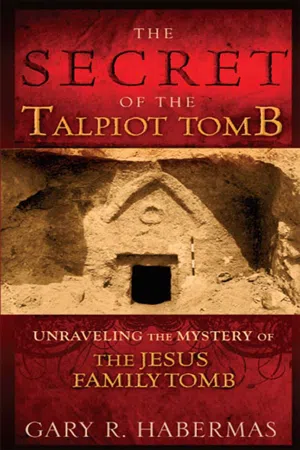
eBook - ePub
The Secret of the Talpiot Tomb
Unraveling the Mystery of the Jesus Family Tomb
- 96 pages
- English
- ePUB (mobile friendly)
- Available on iOS & Android
eBook - ePub
About this book
In response to recent world news headlines, The Secret of the Talpiot Tomb is a full-color text and visual presentation of the most compelling evidence for Jesus' victory over death. Written by research professor Gary Habermas, considered by many to be the world's leading apologist for the historicity of Jesus' resurrection, this case for Christ's immortality is placed in the context of new claims made about the alleged bones of Jesus having been discovered in the so-called Talpiot tomb located in southeast Jerusalem. Habermas examines the controversial case with exceptional clarity and precision, showing a preponderance of evidence against the Talpiot Hypothesis and a compelling argument for Christ's bodily resurrection.
Frequently asked questions
Yes, you can cancel anytime from the Subscription tab in your account settings on the Perlego website. Your subscription will stay active until the end of your current billing period. Learn how to cancel your subscription.
At the moment all of our mobile-responsive ePub books are available to download via the app. Most of our PDFs are also available to download and we're working on making the final remaining ones downloadable now. Learn more here.
Perlego offers two plans: Essential and Complete
- Essential is ideal for learners and professionals who enjoy exploring a wide range of subjects. Access the Essential Library with 800,000+ trusted titles and best-sellers across business, personal growth, and the humanities. Includes unlimited reading time and Standard Read Aloud voice.
- Complete: Perfect for advanced learners and researchers needing full, unrestricted access. Unlock 1.4M+ books across hundreds of subjects, including academic and specialized titles. The Complete Plan also includes advanced features like Premium Read Aloud and Research Assistant.
We are an online textbook subscription service, where you can get access to an entire online library for less than the price of a single book per month. With over 1 million books across 1000+ topics, we’ve got you covered! Learn more here.
Look out for the read-aloud symbol on your next book to see if you can listen to it. The read-aloud tool reads text aloud for you, highlighting the text as it is being read. You can pause it, speed it up and slow it down. Learn more here.
Yes! You can use the Perlego app on both iOS or Android devices to read anytime, anywhere — even offline. Perfect for commutes or when you’re on the go.
Please note we cannot support devices running on iOS 13 and Android 7 or earlier. Learn more about using the app.
Please note we cannot support devices running on iOS 13 and Android 7 or earlier. Learn more about using the app.
Yes, you can access The Secret of the Talpiot Tomb by Gary R. Habermas in PDF and/or ePUB format, as well as other popular books in Theology & Religion & Christian Theology. We have over one million books available in our catalogue for you to explore.
Information
CHAPTER 1
INTRODUCTION
INTRODUCTION
THE TALPIOT TOMB AND
JEWISH BURIAL PRACTICES
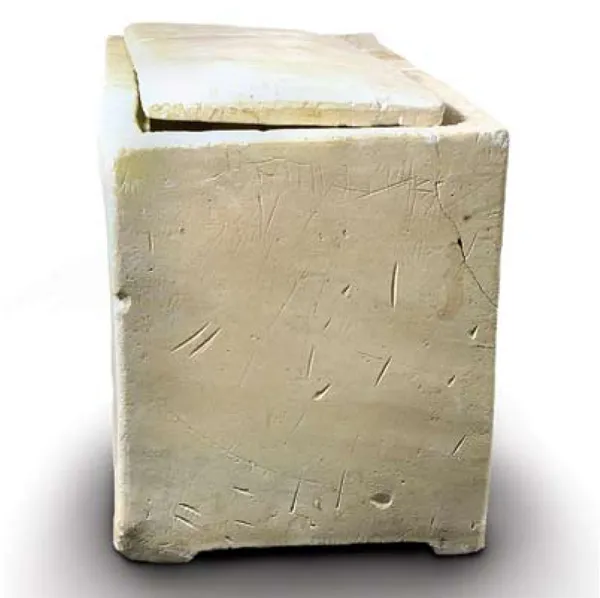
Photo: Getty Images
At first almost no one noticed. Israeli archaeologist Amos Kloner reported that on March 28, 1980, the entrance to a Jewish burial tomb was discovered in the East Talpiot region of Jerusalem.1 At that time, there was no hint of the controversy that would follow later. Actually, little happened or was published on the subject over the next fifteen years. Then during the Easter season of 1996, the BBC broadcast a documentary entitled, “The Body in Question.”2 Still there was not much of a splash.

Photo: NASA/GSFC/METI/ERSDAC/JAROS, and U.S./Japan ASTER Science Team
The undisputed facts of the case were quite simple. In the Talpiot Tomb, ten ossuaries, or stone bone boxes, were found, six of which had names inscribed on them. The controversy arose as certain individuals tried to match those names to particular historical figures, including Jesus of Nazareth.
Professional archaeologist Eliot Braun was the first to be dispatched to the site, according to Simcha Jacobovici and Charles Pellegrino. Yosef Gat, an antiquities inspector, went as well. Kloner, another Israeli archaeologist and Ph.D. student, also joined this team of investigators.3
Jewish Burial Practices and Jesus' Burial
The Jews required that dead bodies be buried within 24 hours after death. Typically, two sorts of Jewish burial practices were used in the first century A.D. The less common, but better known, involved a burial cave or tomb cut out of the rock that surrounded the city of Jerusalem. Each such tomb included one or more chambers surrounded by rows of loculi, which were burial compartments about the length of a body, also cut into the rock.
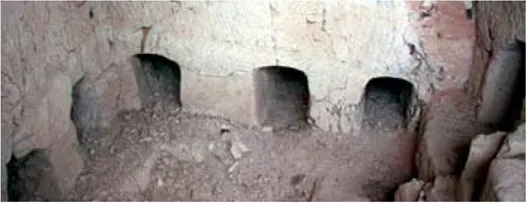
First century loculi at Midras. Photo:HolyLandPhotos.org
Each tomb belonged to an extended family and the dead were buried there over several generations. Upon the death of a family member, the dead body was washed, annointed with oil, and then wrapped in a burial shroud. It was then placed in a loculus, with the opening being sealed with a stone slab. Another stone was placed over the outside entrance to the tomb.4
First century example of a rolling tombstone from Midras, southwest of Jerusalem. Photo:HolyLandPhotos.org
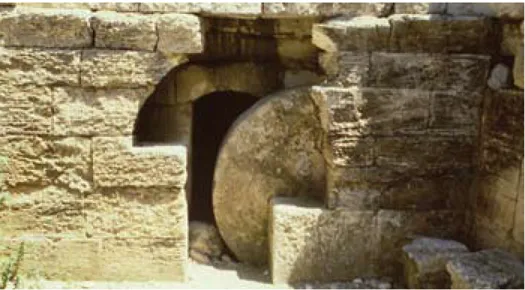
The body would lie in the tomb for a year or so, during which time the flesh decayed. When only the person's bones remained in the tomb, they were gathered and placed in a stone ossuary (or bone box) and reburied. In a minority of circumstances—about one quarter of the time—names were then carved on the side of the box. Often more than one person was buried in these bone boxes, seriously complicating the matter of later identifying the remains. These ossuaries were only used for 100 years or so.5
BURIAL PROCESS

Cut stone tombs were very expensive, so the more common way to bury the dead was used chiefly by poorer members of Jewish society. In this case, the majority of the population buried their loved ones in “simple, individual trench graves dug into the ground, similar to the way we bury our dead today.” The dirt was then moved back into the trench and a “crude headstone” was usually placed at one end of the burial site to mark the spot. This was not at all dishonorable, but was the most common means of burial. In these cases, nothing would remain to rebury after a year.6
Of the two sorts of Jewish burial, the use of the rock tomb is better known today, probably due to the case of Jesus' death and burial. Magness notes that the Gospels are not only our earliest sources, but that they accurately describe the burial by Joseph of Arimathea in a loculus of his family's own tomb. The body had to be buried before the Sabbath began that same day at sundown. Otherwise they would have to wait until Saturday night, after the Sabbath ended. However, that would have exceeded the requirement for burying a dead body within 24 hours. Joseph had to act very quickly.
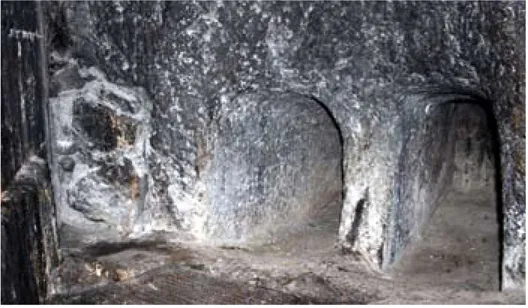
First century loculi at the Church of the Holy Sepulcher, Jerusalem. Photo:HolyLandPhotos.org
So Joseph procured Jesus' dead body, wrapped it in linen, included spices, and made sure that it was buried hastily late Friday afternoon in his own family tomb. In this, the Gospels show familiarity with Jewish Law.7
The Gospels explain that the women returned to see the tomb on Sunday morning. Mark (16:1) and Luke (24:1) specify that they brought spices that they had prepared, apparently to finish Friday afternoon's hasty burial. But all four Gospels teach that when the women arrived, they found the tomb empty. Afterward, the women and others saw the risen Jesus.
The traditional understanding of these events has been challenged by the ossuaries from the Talpiot Tomb. The news dominated the religious world for weeks, beginning days prior to the extended New York press conference on February 27, 2007, followed by the airing of the Discovery Channel documentary on March 4. The latter was followed by a scholarly discussion. In this book we will investigate many challenges, both pro and con, as to whether the claims of the Talpiot Hypothesis can be upheld, over against the New Testament view.
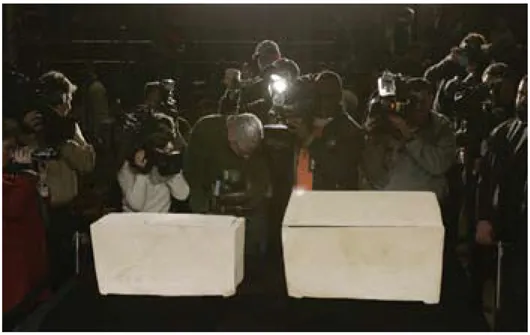
The 2007 press conference promoting the documentary. The Jesus ossuary is on the left, the “Mary Magdalene” ossuary is on the right. Photo: Stan Honda/AFP/Getty Images.
A Word about Sources
To the chagrin of scholars, the Talpiot story has largely been aired in the popular press, from television and radio discussions, to news items, to perhaps hundreds of written publications, often found on the Internet. To be sure, many of these stories and news articles involved scholarly input, sometimes even doing an excellent job of finding the right specialists. Still, many other sources appeared from popular news outlets, as well as on personal and group Web sites. It is not surprising, therefore, that from the beginning this has been a popular story, especially since the original television and book versions were largely associated with the claims of two movie and film producers.
As a mainstream story, much of the information as well as many of the best quotations and critiques have appeared in popular venues. Accordingly, the sources that are employed in this book will be derived from both popular and scholarly areas. We will strive to cite recognized scholars whenever we can, even if the citations are found in popular sources.
Notes
1. Amos Kloner, “A Tomb with Inscribed Ossuaries in East Talpiyot, Jerusalem,” 'Atiquot, Vol 29 (1996), 15.
2. James Tabor, The Jesus Dynasty: The Hidden History of Jesus, His Royal Family, and the Birth of Christianity (New York: Simon and Schuster, 2006), 23.
3. Simcha Jacobovici and Charles Pellegrino, The Jesus Family Tomb (N.Y.: Harper Co...
Table of contents
- Cover
- Full Title
- Copyright
- Table of Contents
- Preface
- Chapter 1
- Chapter 2
- Chapter 3
- Chapter 4
- Chapter 5
- Appendix
- Postscript